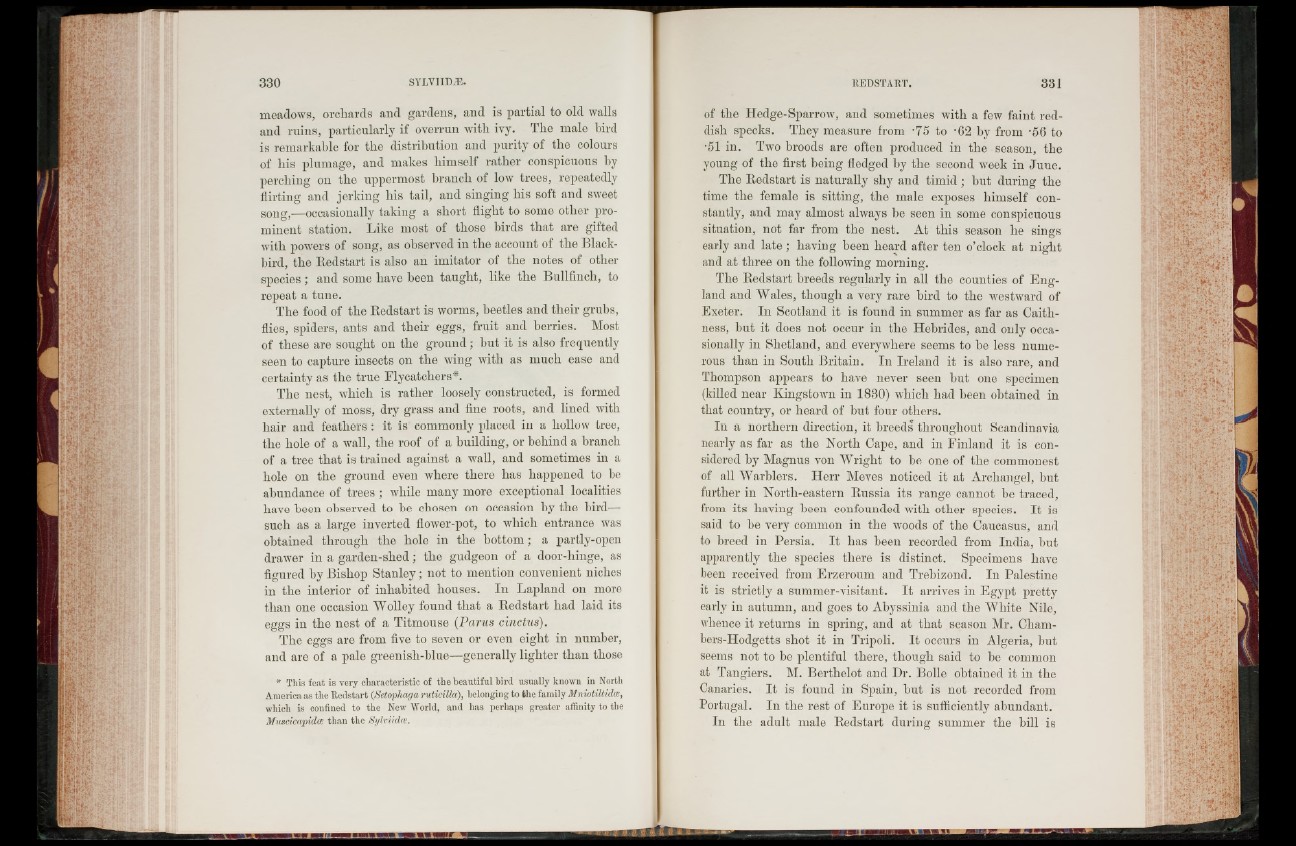
meadows, orchards and gardens, and is partial to old walls
and ruins, particularly if overrun with ivy. The male bird
is remarkable for the distribution and purity of the colours
of his plumage, and makes himself rather conspicuous by
perching on the uppermost branch of low trees, repeatedly
flirting and jerking his tail, and singing his soft and sweet
song,—occasionally taking a short flight to some other prominent
station. Like most of those birds that are gifted
with powers of song, as observed in the account of the Blackbird,
the Redstart is also an imitator of the notes of other
species ; and some have been taught, like the Bullfinch, to
repeat a tune.
The food of the Redstart is worms, beetles and their grubs,
flies, spiders, ants and their eggs, fruit and berries. Most
of these are sought on the ground; hut it is also frequently
seen to capture insects on the wing with as much ease and
certainty as the true Flycatchers*.
The nest, which is rather loosely constructed, is formed
externally of moss, dry grass and fine roots, and lined with
hair and feathers : it is commonly placed in a hollow tree,
the hole of a wall, the roof of a building, or behind a branch
of a tree that is trained against a wall, and sometimes in a
hole 011 the ground even where there has happened to be
abundance of trees ; while many more exceptional localities
have been observed to he chosen on occasion by the bird—
such as a large inverted flower-pot, to which entrance was
obtained through the hole in the bottom; a partly-open
drawer in a garden-shed; the gudgeon of a door-liinge, as
figured by Bishop Stanley; not to mention convenient niches
in the interior of inhabited houses. In Lapland 011 more
than one occasion Wolley found that a Redstart had laid its
eggs in the nest of a Titmouse (Parus cinctus).
The eggs are from five to seven or even eight in number,
and are of a pale greenish-blue—generally lighter than those
* This feat is very characteristic of the beautiful bird usually known in North
America as the Redstart (Setophaga ruticilla), belonging to the family Mniotiltidce,
which is confined to the New World, and has perhaps greater affinity to the
Mnscicapida: than the Sylviidn;.
of the Hedge-Sparrow, and sometimes with a few faint reddish
specks. They measure from -75 to -62 by from -56 to
•51 in. Two broods are often produced in the season, the
young of the first being fledged by the second week in June.
The Redstart is naturally shy and timid ; hut during the
time the female is sitting, the male exposes himself constantly,
and may almost always he seen in some conspicuous
situation, not far from the nest. At this season he sings
early and late ; having been heard after ten o’clock at night
and at three on the following morning.
The Redstart breeds regularly in all the counties of England
and Wales, though a very rare bird to the westward of
Exeter. In Scotland it is found in summer as far as Caithness,
hut it does not occur in the Hebrides, and only occasionally
in Shetland, and everywhere seems to he less numerous
than in South Britain. In Ireland it is also rare, and
Thompson appears to have never seen hut one specimen
(killed near Kingstown in 1830) which had been obtained in
that country, or heard of hut four others.
In a northern direction, it breeds throughout Scandinavia
nearly as far as the Kortli Cape, and in Finland it is considered
by Magnus von Wright to he one of the commonest
of all Warblers. Herr Meves noticed it at Archangel, hut
further in North-eastern Russia its range cannot he traced,
from its having been confounded with other species. It is
said to be very common in the woods of the Caucasus, and
to breed in Persia. I t has been recorded from India, but
apparently the species there is distinct. Specimens have
been received from Erzeroum and Trebizond. In Palestine
it is strictly a summer-visitant. I t arrives in Egypt pretty
early in autumn, and goes to Abyssinia and the White Nile,
whence it returns in spring, and at that season Mr. Cliam-
bers-Hodgetts shot it in Tripoli. It occurs in Algeria, hut
seems not to be plentiful there, though said to be common
at Tangiers. M. Bertlielot and Dr. Bolle obtained it in the
Canaries. I t is found in Spain, hut is not recorded from
Portugal. In the rest of Europe it is sufficiently abundant.
I 11 the adult male Redstart during summer the bill is